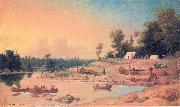
pintura al óleo, una gusto verdadero de los viejos maestros
|
Paul Kane
|
|||
|
|
|||
| (September 3, 1810 - February 20, 1871) was an Irish-born Canadian painter, famous for his paintings of First Nations peoples in the Canadian West and other Native Americans in the Oregon Country. A largely self-educated artist, Kane grew up in Toronto (then known as York) and trained himself by copying European masters on a study trip through Europe. He undertook two voyages through the wild Canadian northwest in 1845 and from 1846 to 1848. The first trip took him from Toronto to Sault Ste. Marie and back. Having secured the support of the Hudson's Bay Company, he set out on a second, much longer voyage from Toronto across the Rocky Mountains to Fort Vancouver and Fort Victoria in the Columbia District, as the Canadians called the Oregon Country. | |||
|
|
|||
|
|
Encampment new24/Paul Kane-495733.jpg Pintura Identificación:: 73971 |
Date June 10, 1846 Medium Oil on paper Dimensions 20.6 X 34 cm (8.11 X 13.39 in) cyf | |
Altura Anchura |
Pulgadas/CM |
||
|
X |
|
||
|
|
|||





